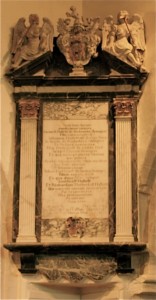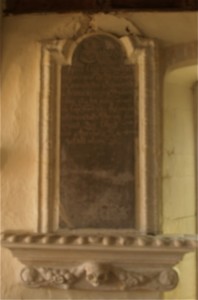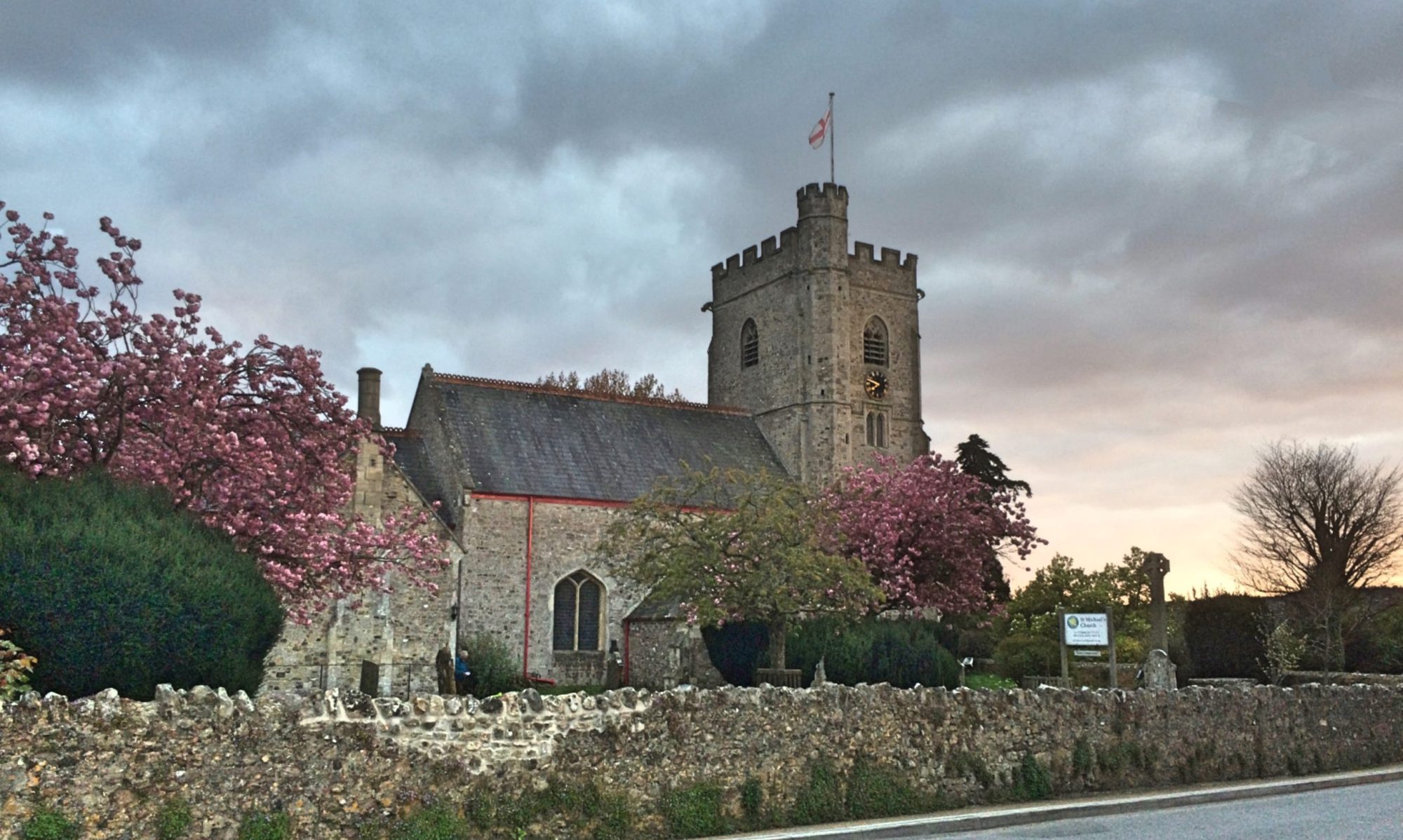The Hallett Monument
This monument in the corner of the nave above the hagioscope was erected to the memory of several members of the Hallett family, but principally to the younger Richard Hallett, whose will specified that a monument should be erected.

Richard died in January 1747; his wife, Meliora Hothersall, from Giddy (Gidea) Hall in Essex, had died and was buried in Axmouth in 1733. Richard’s son, John, survived his father by only a few months. He had married Jane Southcott of Dulcis (near Kilmington), and the two sons of the marriage, Richard Hothersall Hallett, and Southcott Hallett, were left with the responsibility of carrying out the wishes of their grandfather. Doubtless, the monument was erected with the assistance of their widowed mother, as they would have been merely schoolboys at the time. As is recounted in the somewhat pedantic eighteenth-century Latin inscription, the task was completed by 1749.
The Hallett Family
It may be appropriate, at this point, to include a few lines about this family, lords of the manor, and owners of most of the parish for almost two hundred years.
The first Richard Hallett, uncle of the Richard commemorated, had prospered from the sugar plantations in Barbados. Many 17th Century Dorset merchants were involved in the slave trade and when Richard returned to Lyme Regis in 1699 he is said to have brought a retinue of black servants with him. It should be said that the 21st Century Church of England deplores slavery in all its forms and has roles both in supporting those who have been caught up in it and in seeking longer term solutions to eradicate such exploitation from our communities. Against this backdrop, however, the Halletts did much to benefit the community with the wealth they had acquired. The first Richard Hallett’s connection with Axmouth began in 1691, when he bought the Stedcombe estate from Sir Walter Yonge. At the time, the manor house was in ruins from its destruction in 1645, during the Civil War, and Richard put in hand its rebuilding. Before he could occupy the new Stedcombe, he died leaving no descendants.
He bequeathed his estate to sons of his brother, and one of these, another Richard, inherited Stedcombe and other property, both in this country and in Barbados. He and his wife made their home in Axmouth, and both are buried here. On the death of Richard, early in 1747, the Burial Register (unusually) comments universally lamented. Of his two sons, only one, John survived him, and by a few months only, but we have already seen how his marriage to Jane Southcott produced two grandsons. The elder of these, Richard Hothersall Hallett, whilst still a young boy, inherited the estate from his grandfather.
In due time the young Richard was himself married, to Sarah Cooke, of Thorncombe, and they raised a family of nine children, though several did not survive infancy. The father became Vicar of Axmouth, and held this office, as well as that of squire, until his own death in 1814. His eldest surviving son, John Hothersall Hallett, inherited the manor, and lived to the great age of 88 years. Besides having been credited with the actual building of the organ which was later presented to the church, his name is chiefly remembered for his great passion for the restoration of the ancient harbour of Axmouth. For a number of years, he did not dwell in Stedcombe House, but at Haven Cliff, which he also owned, and which overlooked the harbour. He was active in obtaining Parliamentary authority for substantial works to be undertaken in the harbour area, and during the 1830s and 1840s, these were carried out, thus enabling sea-going vessels once more to enter and to load and discharge their cargoes. The coming of the railway, first to Axminster and finally to Seaton, in 1868, ensured the demise of the maritime trade, and this was hastened by severe winter storms: that of 1869 caused irreparable damage, after which the harbour was to decline into its present day state of picturesque decay.
The one surviving brother of John, Richard Southcott Hallett, became Vicar of Axmouth in his father’s place, nominally until his own death in 1858, but in actual fact, he had taken little part in the affairs of the parish after about 1836. Instead, a curate named George Thomas Comyns, B.A. took over. He was the son of Maria, Richard’s sister, who had married John Comyns, a priest from Bishopsteignton. When Richard Hothersall Hallett, who had been both squire and Vicar, died in 1814, his successor who served as Vicar only, had to have a suitable residence, and it was at about this time that the building standing above the village, now known as the Old Vicarage, came to be built. It is known that George Comyns, his wife and family were living here in 1841, through the 1850s, and in 1861, by that time as Vicar in his own right.
The death of Richard Southcott Hallett, on 2 January 1858, is recorded in Pulman’s Weekly News, but no mention of his burial appears either there or in the Axmouth Registers. He had married, and the union produced two sons to survive infancy. The elder of these, William Trelawny Ellon Hallett, who became a barrister by profession, inherited the manor and estate upon the death of his uncle in 1864. He had married Ellen Whitehouse about 1850, and he died on 2 December 1889. By that time, the estate was heavily in debt, and his widow was obliged to leave Stedcombe, and live elsewhere locally until her own death in 1907. None of the children survived their father, and the whole estate was sold as an entity in 1890. Meanwhile, William’s younger brother, Clements Thomas Hallett, a Colonel in the Bengal Lancers, had had an eventful career in India. He retired and returned to Axmouth, and lived for many years at Haven Cliff, where he died in 1908. His wife moved to Dawlish and died there in 1918. A daughter, Catherine, died in 1931, and is buried near her parents in the churchyard.
The Searle Monument
On the wall of the South Aisle near to the Bindon Chapel is a small stone tablet, inscribed to the memory of William Searle, who died in April 1726. His will included a bequest of an annual rent charge of 32 shillings (£1.60), to be paid in perpetuity for providing instruction in reading for four poor children of Axmouth. Though now of little practical value, the amount is still paid each year, and is administered locally.


